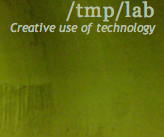Difference between revisions of "Interactive lasers"
ThierryC2014 (talk | contribs) |
ThierryC2014 (talk | contribs) |
||
| Line 31: | Line 31: | ||
=== DIY projects === | === DIY projects === | ||
| + | [http://elm-chan.org/works/vlp/report_e.html] : a DIY laser projector made from scratch. | ||
| + | Even the galvanometers are home-built ! | ||
| + | |||
| + | In particular, there is a detailed study of the design of the galvanometers' servo loop control : galvanometers feature inertia like any mechanical devices, and achieving fast and accurate moves requires to "compensate" the galvanometers' drive signals with respect to their sensed position. | ||
=== [http://ether-dream.com/ Ether-dream dac] === | === [http://ether-dream.com/ Ether-dream dac] === | ||
Revision as of 00:10, 6 January 2015
(WIKI IN PROGRESS)
Goals
The main idea is to add interactivity to "leisure" lasers. i.e with a gamepad one can play to old style vector games on city buildings. See picture at bottom.
Different levels of complexity are possible. Commercial lasers uses ilda files/connections to draw whatever you want, but you can build your own, see hardware section.
- The very fast and easy plan is to switch ilda scenes according to some inputs. You can use already made ilda files (see download section) in a SDcard plugged inside the laser fixture and use DMX protocol to switch. DMX usb cards are cheap, usually we use enttec ones. DMX controlled lasers are cheaper than
- If the plan is too draw live, it depends on the laser fixture DIY or commercial. Lot of possibilities depending on the number of colors, from using an arduino, a 5.1 USB soundcard upt to use commercially (opensource) cards using the standarts ilda connect ports.
- In any way, such lasers must feature X- and Y-scanners (i.e. galvanometer-moved mirrors) in order to position the beam accurately
Hardware
Obviously there is DIY Lasers and commercial ones and there is a bunch of cards integrating some DACs to talk to the laser fixture.
A great forum for bootstrap your project is laser freak that comes in different langages.
We play with two different setups :
- a green DIY laser made at la Blackboxe with a lasershark USB DAC card.
- an ilda DB25 ports RGB commercial laser for clubs with an Etherdream USB DAC card. Obviously is much more expensive but has some great advantage : the ether dream is directly tcp/IP controlled, so you can imagine very cool projects with very easy setup and of course the programming langage you prefer.
Commercial Lasers
Warning ! Not all lasers can draw anything ! Only the ones featuring scanners (i.e. galvanometer-moved mirrors) for the X- and Y-axes can do it (unlike the cheapest ones, which only draw random patterns).
On commercial lasers, the standard way to drive the beam is the DB25-connector-based ILDA interface (source : laserfx.com). It is based on analog differential control signals.
Therefore you'll need some external hardware capable of outputting such signals, be it standalone or controlled by a host computer. Such hardware is usually named concisely "DAC".
DIY projects
[1] : a DIY laser projector made from scratch.
Even the galvanometers are home-built !
In particular, there is a detailed study of the design of the galvanometers' servo loop control : galvanometers feature inertia like any mechanical devices, and achieving fast and accurate moves requires to "compensate" the galvanometers' drive signals with respect to their sensed position.
Ether-dream dac
This is an ILDA control box which can either work as standalone (displaying a sequence of ILDA scenes tored internally or on an SD-card) or receive IP frames for driving the beam.
The firmware is open-source (but what about the hardware ?)
An "Asteroids"-variant game from Brandon Thomas (Echelon) on GitHub

